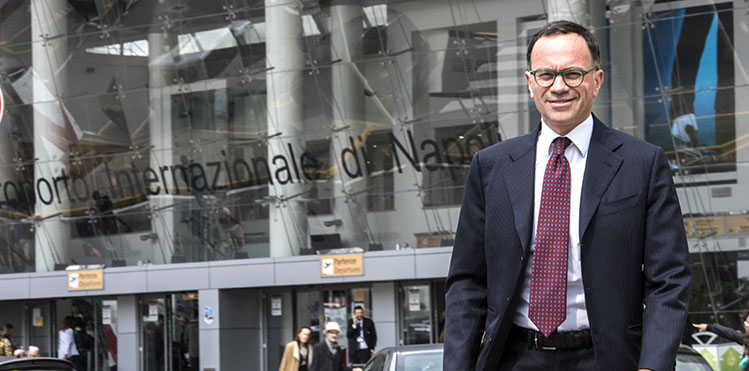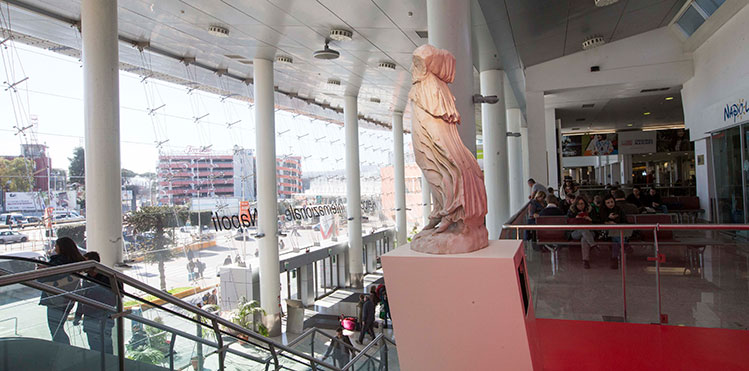Naples International Airport is hosting this year’s ACI EUROPE Regional Airports’ Conference & Exhibition, 14-16 May. Ahead of the event, the airport’s CEO Armando Brunini spoke with Marta Dimitrova.

Armando Brunini, CEO Naples International Airport: “I believe that Naples Airport, the city and the region it serves are finally seeing the traffic volumes and the touristic flows they deserve. We had an unexploited potential and we triggered growth with a well thought out and convincing marketing proposition to airlines.”
Last year, Naples Airport processed just under 8.58 million passengers, a 27% rise over 2016, making it the fastest growing airport in Italy.
“I believe that Naples Airport, the city and the region it serves are finally seeing the traffic volumes and the touristic flows they deserve,” enthuses Armando Brunini, CEO Naples International Airport. “We had an unexploited potential and we triggered growth with a well thought out and convincing marketing proposition to airlines.”
Connectivity is an obvious powerful stimulus of demand and having, in just four years, doubled direct routes and attracted both easyJet and Ryanair to establish bases at the airport, helps Europeans discover this surprising and authentic city, while Neapolitans are learning that flying direct to many European cities is affordable.
Naples Airport is undoubtedly set on a path of success in the forthcoming years. easyJet and Ryanair will be the main drivers of the growth, while the airport has already been presented with clear opportunities from a wide range of airlines, including hub carriers, to increase frequencies and also launch new direct routes.
“Specifically, in terms of hub connectivity, there will be two new important services in 2018: Air Italy (formerly Meridiana, now with Qatar Airways as relevant shareholder) has just announced its new strategy focused on Milan Malpensa as a hub for intercontinental services with two feeding flights from Naples, and Aeroflot will commence a daily service to Moscow starting mid summer.”
Reaching the 100-route target by next summer
Driven by a strong focus on its continuously evolving marketing strategy, the airport has been working hard to improve its seasonality profile, which has seen some positive results. In the current winter season Naples Airport offers 63 scheduled routes, 22 more than the same period last year. This has already resulted in a remarkable +47% growth in passenger numbers in the first three months of the low season.
Overall, the airport is hoping to reach the 100-route target by next summer. Brunini explains: “We will still be focusing on the network of European destinations with six new routes: Belfast, Kefalonia, Grenada, Faro, Sharm el Sheik and Tenerife, our first service ever to the Canary Islands. Our domestic network will see the addition of Alghero in Sardinia bringing the total to 15 Italian routes. For 2019 and onwards we are targeting one or two strategic intercontinental direct routes where we have passenger data showing a well-established traffic demand.”
“Naples Strategic Plan for Tourism”
As an airport business, Naples Airport is naturally counting on the long-term development of incoming tourism flows, while also playing an important role in enhancing the international connectivity of the region. The airport is, therefore, actively engaging with both the local government and the private sector in order to improve destination marketing and management. “We continuously contribute with strategic input; we had a key role in the preparation of the “Naples Strategic Plan for Tourism” recently adopted by the Municipality and our management is often the author of newspaper articles or is involved in speaking in conference on tourism. At the same time, we understand the importance of showcasing updated best practices for local tourism development and we have delivered specific digital and social marketing campaigns. One is “on air” right now in France, UK, and Germany. We are also a founding partner of Naples Convention Bureau, which aims to promote Naples as a MICE (Meetings, Incentives, Conventions, and Events) destination. Overall, we are considered a credible and respected stakeholder by all parties and we will consistently be engaged in this area well aware that the “rewards” of our efforts are in the long term.”
Ambitious climate action
Last year, GESAC, operator of Naples Airport, implemented several projects to reduce CO2 emissions and launched environmental awareness campaign aimed at energy consumption reduction, sustainable mobility and waste management. For instance, it is substituting most of the vehicles and equipment operating at the airport with electrical ones, while also encouraging the use of public transport for the airport staff. Brunini adds: “We are also active in the research field and we recently announced a joint programme with the University of Naples to explore new sustainable mobility solutions for passengers and operators.”
Moreover, the airport has embarked on a three-year project to create a power generation plant that will bring it to carbon neutrality. The power generation plant is designed to achieve energetic efficiency using methane gas to produce enough electricity and hot water to serve the passenger terminal, the cargo terminal and other office buildings in close proximity to the airport. “The reduction of CO2 emissions may be estimated at 900 tonnes per year, and this will help us, with other activities, to reach Level 3+ of ACI Airport Carbon Accreditation. We are now in the final stage of development of the project, as all the preliminary activities are completed, and the construction of the plans will start this year.”

Naples Airport continues to improve the passenger experience to provide a memorable first impression of Naples’ authenticity.
New DHL cargo building, car rental facilities and metro station
2019 will bring an array of development projects at the airport, including construction of a new cargo building dedicated to DHL, new upgraded car rental facilities and a metro station.
The new cargo building project will develop a new logistic area of about 9,000sqm, with two hangars and a service area for cargo operations. More than half of the new cargo building will be dedicated to DHL, which only began flying to Naples a few years ago, yet its double-digit growth needs new facilities to continue developing the business. “In 2019, when we deliver the new cargo building, DHL will have the appropriate operational environment to make Naples Airport its gateway to Southern Italy.”
The rapid increase in traffic in the last years has also pushed the airport to think creatively in terms of improving the passenger experience. By 2019, the car rental facilities will be relocated from a more remote area to a closer proximity to the terminal building. “We believe that passenger experience will definitely be improved and thus we will give proper attention to those passengers having their first impression of Naples at our airport.”
Another project that is currently underway at the airport is the construction of the metro station, which is expected to be complete in the next three to four years. Brunini says: “Our expectations are high; we will be only one stop from the business district, two from the central railway station and three from the centre of town. We hope to be seeing less traffic on the road system to and from the airport and seamless integration with the high-speed train will surely enhance the enlargement of our catchment area and our overall competitive position.”
While continuing its rapid expansion, Italy’s fastest growing airport is also focusing its efforts on catering for its growth. “We are seeking to create a regional airports system with the airport of Salerno-Amalfi Coast, which is currently underdeveloped, under the management of one company. This would enable us to accommodate the doubling of traffic foreseen for the next two or three decades, sustainably contributing to the development of our region. The strategic issues we need to face in the near future are to avoid a capacity crunch and manage a sustainable growth of our infrastructure keeping the passenger experience easy and exciting,” Brunini concludes.







